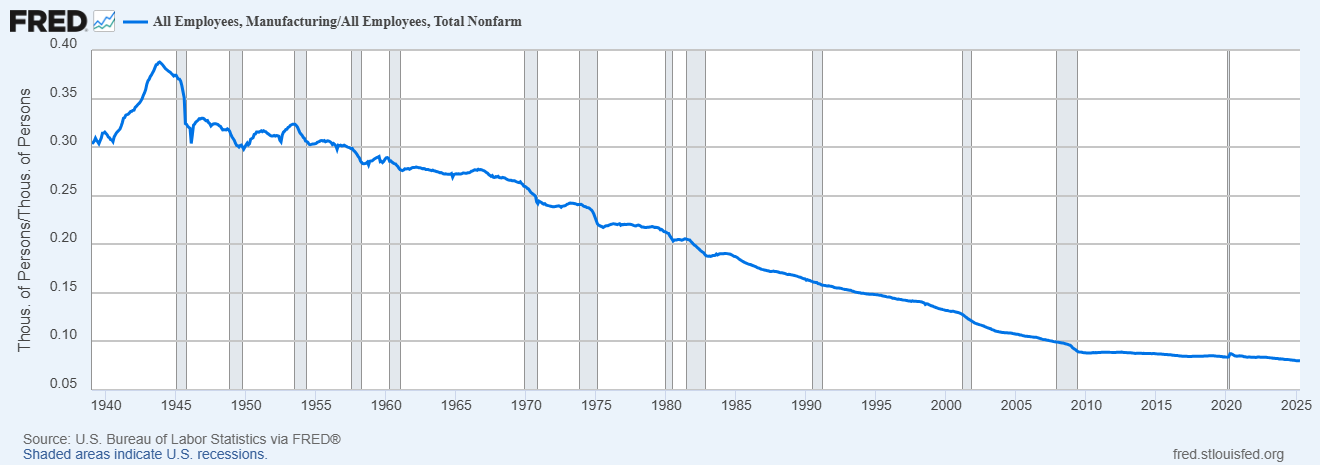Manufacturing output in America is booming. According to the Federal Reserve’s Industrial Production Index, US factory output stood at 103.9 in April 2025, near its all-time high. The machines are humming.
But that productivity masks two uncomfortable truths: manufacturing jobs are vanishing, and the wages in those jobs are not especially high. So why are politicians rushing to revive a labor model in retreat?
The answer is simple: nostalgia sells. But sound economic policy requires more than sentiment — it requires a reality check.
The Wage Mirage
Let’s start with the supposed appeal of manufacturing wages.
In April 2025, average weekly earnings in manufacturing stood at $1,402.40. That sounds impressive — until you compare it to the total private sector average of $1,236.86. That’s just a 13 percent premium. Nice, but far from revolutionary.
Dig deeper, and the story worsens. The average hourly earnings in manufacturing were $35.06, below the overall private sector’s $36.14. The only reason manufacturing’s weekly pay looks stronger is because factory workers are logging more hours — not earning higher rates.
This contradicts the popular talking point that manufacturing offers uniquely “good jobs.” They’re decent, sure — but not disproportionately better than other sectors. And certainly not enough to justify government favoritism.
Where the Jobs Went — and Why
The truth is that manufacturing jobs have been declining for decades, long before China joined the World Trade Organization in 2001 or NAFTA passed in 1994.
In fact, the share of US nonfarm employment in manufacturing peaked in the early 1950s at over 30 percent. As of April 2025, it stands at just 8 percent, according to Federal Reserve data. The absolute number of factory jobs peaked in 1979, years before globalization became a political scapegoat.

Blaming trade deals for this structural shift ignores the real culprits: poor policy decisions at every level of government.
States in the Rust Belt doubled down on unionized labor models, raised business taxes, and created regulatory minefields that discouraged investment and entrepreneurship. Federal policies layered on compliance burdens, from OSHA to EPA mandates, while failing to reform outdated labor and tax codes.
Simultaneously, capital became more productive and affordable. In response to high labor costs and inflexible work rules, firms invested in automation and supply chain restructuring — rational market behavior in the face of poor policy.
If there was a “hollowing out,” it wasn’t caused by China. It was caused by Washington, Albany, and Springfield.
Industrial Policy: The Wrong Answer
Rather than fix what broke labor markets — rigid institutions, perverse tax codes, and regulatory sprawl — today’s political class is dusting off the old playbook of industrial policy.
The logic goes something like this: government should “bring back” manufacturing jobs by picking industries to support, offering subsidies, or restricting imports. This thinking underlies the CHIPS Act, the Inflation Reduction Act, and growing bipartisan calls for trade protectionism.
But industrial policy doesn’t work. It reallocates capital based on political incentives, not economic ones. It props up politically favored firms and industries at the expense of dynamic sectors that don’t have lobbyists in D.C.
More fundamentally, it misunderstands what made America rich in the first place: the freedom to specialize, innovate, and trade. We didn’t prosper by controlling the direction of jobs. We prospered by getting government out of the way.
Even if these policies “succeed” in creating more factory jobs — which is far from certain — they will come at great cost: higher prices, distorted markets, and reduced competitiveness. In trying to become more like China, we risk becoming less like America.
What Real Reform Looks Like
If we want a vibrant labor market — one that pays well and creates opportunity — we should focus on free-market reforms, not nostalgia-driven interventions.
- Cut marginal tax rates on both labor and capital, especially at the state level.
- Eliminate crony subsidies that reward political connections over performance.
- Deregulate labor markets, making it easier to hire, fire, and negotiate flexible work arrangements.
- Expand school choice and skills-based education, not just degrees.
- End protectionist tariffs that raise prices for consumers and penalize supply chain resilience.
Manufacturing will continue to be a vital part of the American economy — but mostly through output and innovation, not through raw headcounts. That’s not a loss. It’s the mark of a mature economy.
Milton Friedman put it best: “The great danger to the consumer is the monopoly — whether private or governmental.” Industrial policy empowers both. Free markets empower people.
Conclusion: Face Reality, Don’t Fantasize It
Manufacturing output is thriving in the United States. Workers are producing more than ever. But jobs and wages in manufacturing aren’t what they used to be, and trying to force them back through government intervention won’t change that.
We shouldn’t fall for the illusion that factory jobs can or should be the backbone of modern labor markets. We should instead focus on creating an economic environment where innovation flourishes, and people can find meaningful, well-paying work — wherever that may be.
America doesn’t need more central planning. It needs more freedom.
